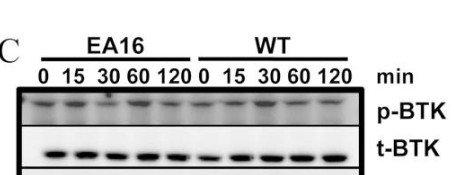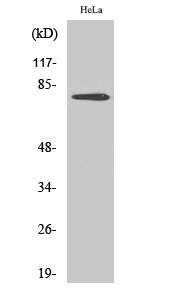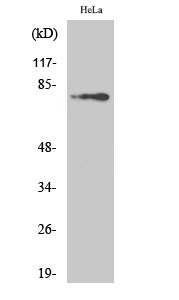
Catalog: KA3053C
Size
Price
Status
Qty.
96well
$330.00
In stock
0
Add to cart


Collected


Collect
Main Information
Reactivity
Human, Mouse, Rat
Applications
ELISA
Conjugate/Modification
Unmodified
Detailed Information
Storage
2-8°C/6 months,Ship by ice bag
Modification
Unmodified
Detection Method
Colorimetric
Related Products
Antigen&Target Information
Gene Name:
BTK
show all
Other Name:
Tyrosine-protein kinase BTK ;
Agammaglobulinaemia tyrosine kinase ;
ATK ;
B-cell progenitor kinase ;
BPK ;
Bruton tyrosine kinase ;
Agammaglobulinaemia tyrosine kinase ;
ATK ;
B-cell progenitor kinase ;
BPK ;
Bruton tyrosine kinase ;
show all
Background:
catalytic activity:ATP + a [protein]-L-tyrosine = ADP + a [protein]-L-tyrosine phosphate.,cofactor:Binds 1 zinc ion per subunit.,disease:Defects in BTK are the cause of X-linked agammaglobulinemia (XLA) [MIM:300755]; also called X-linked agammaglobulinemia type 1 (AGMX1) or immunodeficiency type 1 (IMD1). XLA is a humoral immunodeficiency disease which results in developmental defects in the maturation pathway of B-cells. Affected boys have normal levels of pre-B-cells in their bone marrow but virtually no circulating mature B-lymphocytes. This results in a lack of immunoglobulins of all classes and leads to recurrent bacterial infections like otitis, conjunctivitis, dermatitis, sinusitis in the first few years of life, or even some patients present overwhelming sepsis or meningitis, resulting in death in a few hours. Treatment in most cases is by infusion of intravenous immunoglobulin.,disease:Defects in BTK may be the cause of X-linked hypogammaglobulinemia and isolated growth hormone deficiency (XLA-IGHD) [MIM:307200]; also known as agammaglobulinemia and isolated growth hormone deficiency or Fleisher syndrome or isolated growth hormone deficiency type 3 (IGHD3). In rare cases XLA is inherited together with isolated growth hormone deficiency (IGHD).,enzyme regulation:Inhibited by IBTK. Activated by phosphorylation.,function:Plays a crucial role in B-cell ontogeny. Transiently phosphorylates GTF2I on tyrosine residues in response to B-cell receptor cross-linking. Required for the formation of functional ARID3A DNA-binding complexes.,online information:BTK mutation db,PTM:Autophosphorylated on Tyr-223 and Tyr-551. Phosphorylation of Tyr-223 may create a docking site for a SH2 containing protein.,similarity:Belongs to the protein kinase superfamily. Tyr protein kinase family.,similarity:Belongs to the protein kinase superfamily. Tyr protein kinase family. TEC subfamily.,similarity:Contains 1 Btk-type zinc finger.,similarity:Contains 1 PH domain.,similarity:Contains 1 protein kinase domain.,similarity:Contains 1 SH2 domain.,similarity:Contains 1 SH3 domain.,subunit:Binds GTF2I through the PH domain. Interacts with SH3BP5 via the SH3 domain. Interacts with IBTK via its PH domain. Interacts with GTF2I and ARID3A.,
show all
Function:
protein amino acid phosphorylation, phosphorus metabolic process, phosphate metabolic process, induction of apoptosis, intracellular signaling cascade, protein kinase cascade, I-kappaB kinase/NF-kappaB cascade, mesoderm development, induction of apoptosis by extracellular signals, regulation of cell death, positive regulation of cell death,induction of programmed cell death, phosphorylation, peptidyl-tyrosine phosphorylation, peptidyl-tyrosine modification, calcium-mediated signaling, second-messenger-mediated signaling, developmental maturation,regulation of apoptosis, positive regulation of apoptosis, regulation of programmed cell death, positive regulation of programmed cell death, cell maturation,
show all
Cellular Localization:
Cytoplasm. Cell membrane; Peripheral membrane protein. Nucleus. In steady state, BTK is predominantly cytosolic. Following B-cell receptor (BCR) engagement by antigen, translocates to the plasma membrane through its PH domain. Plasma membrane localization is a critical step in the activation of BTK. A fraction of BTK also shuttles between the nucleus and the cytoplasm, and nuclear export is mediated by the nuclear export receptor CRM1.
show all
Tissue Expression:
Signaling Pathway
Organismal Systems >> Immune system >> Platelet activation
Organismal Systems >> Immune system >> B cell receptor signaling pathway
Organismal Systems >> Immune system >> Fc epsilon RI signaling pathway
Organismal Systems >> Development and regeneration >> Osteoclast differentiation
Human Diseases >> Immune disease >> Primary immunodeficiency
Environmental Information Processing >> Signal transduction >> NF-kappa B signaling pathway
Reference Citation({{totalcount}})
Catalog: KA3053C
Size
Price
Status
Qty.
96well
$330.00
In stock
0
Add to cart


Collected


Collect
Recently Viewed Products
Clear allPRODUCTS
CUSTOMIZED
ABOUT US
Toggle night Mode
{{pinfoXq.title || ''}}
Catalog: {{pinfoXq.catalog || ''}}
Filter:
All
{{item.name}}
{{pinfo.title}}
-{{pinfo.catalog}}
Main Information
Target
{{pinfo.target}}
Reactivity
{{pinfo.react}}
Applications
{{pinfo.applicat}}
Conjugate/Modification
{{pinfo.coupling}}/{{pinfo.modific}}
MW (kDa)
{{pinfo.mwcalc}}
Host Species
{{pinfo.hostspec}}
Isotype
{{pinfo.isotype}}
Product {{index}}/{{pcount}}
Prev
Next
{{pvTitle}}
Scroll wheel zooms the picture
{{pvDescr}}



















